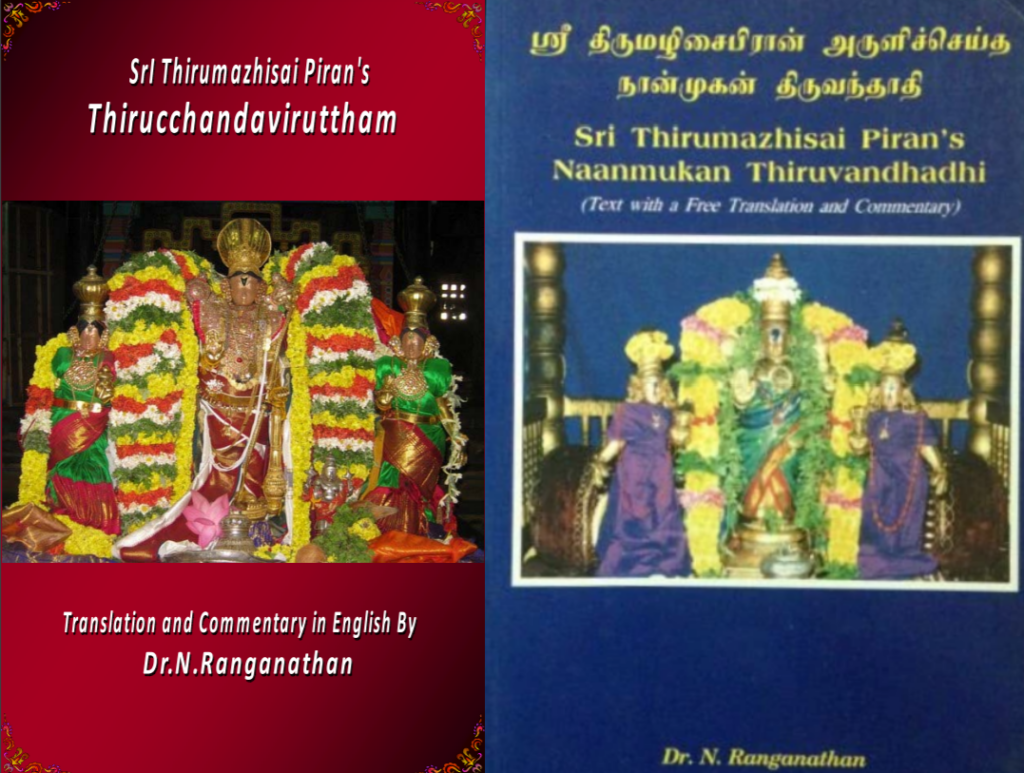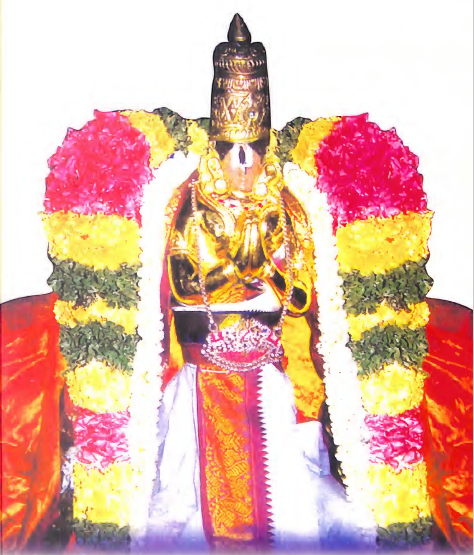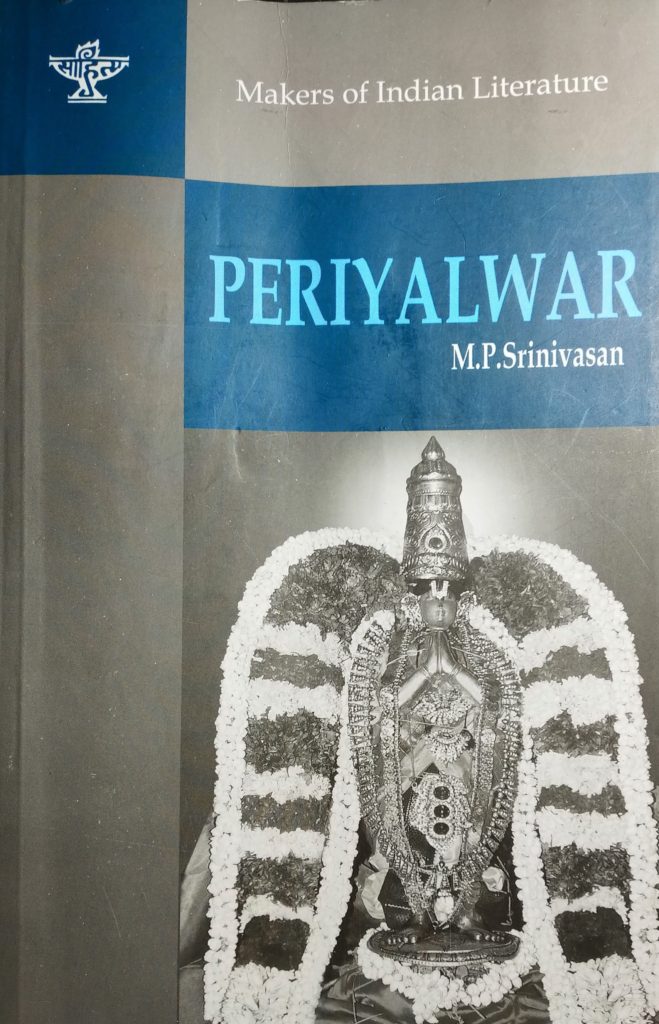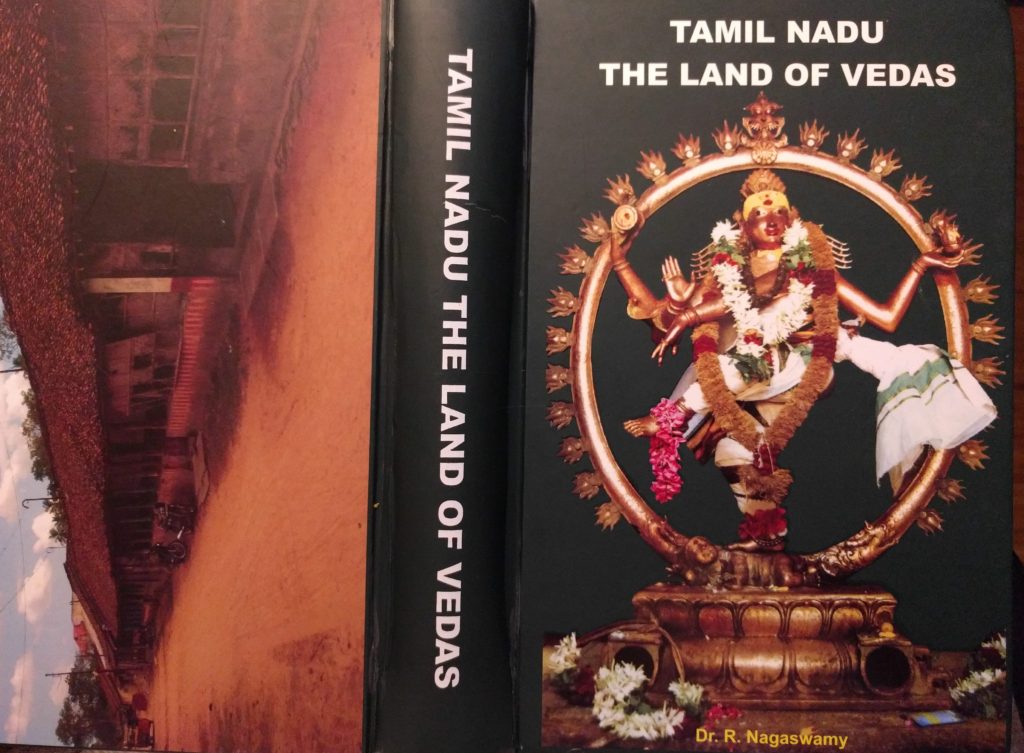Introduction
திருமழிசை (Thirumazhisai) Piran is worshiped as one of the twelve Alvars, the great Bhakti saints and scholars of Sanathana dharma. Some historians date the time period of the Alvars to 6th – 8th century CE, while other scholars state much earlier dates. The Tamizh songs of the Alvars comprise the sacred 4000 Divya Prabandham [5]. The verses are suffused with Bhakti and compassion and speak of liberation through surrender of all ego to the lotus feet of Mahavishnu. Thirumazhisai Alvar’s life story is awe-inspiring and full of amazing incidents. He is considered an incarnation of the Sudarshana Chakra of Sriman Narayana. Hailing from a most humble family he became a towering Vedic seer. He studied the various dharmic schools of thought of his time before becoming a devotee of Vishnu. He surrendered all to the supreme being who in turn listened to his devotee’s words.
The principal references for this introductory article are the works of Dr. N. Ranganathan [1, 2]. The books are available here and here.

Biography
Thirumazhisai Alvar was born in the village of Thirumazhisai near Poovirunda Valli (present day: Poonamallee) located near West Chennai. One account says that he was born to Sage Brigu and his wife as an under-developed fetus and was abandoned in a field under bamboo trees. He was later found and adopted by a woodcutter family. However, due to divine intervention, life was breathed into this form and it grew into an infant who was graced by the vision of Bhagavan when he first opened his eyes. Later, when this vision disappeared, the child began to cry. Due to this transcendent vision, the child experienced little hunger or thirst. An old farmer and his wife recognized the divinity within this baby and brought milk for the child daily. One day, the farmer’s wife drank the leftover milk and regained her youth. The couple was blessed with a child, Kani Kannan who later became the Alvar’s disciple.
The divine child became a Yogi at a young age. He learned and explored different Hindu Sampradayas as well as Buddhist and Jain traditions. He was also a Shiva Bhakta before fully immersing himself in Sriman Narayana. It is said that Shiva was impressed by his complete devotion to Narayana and bestowed upon him the title of Bhaktisara.
In a parallel to Sri Krishna, the Alvar identified himself in his works with the humble woodcutter family who raised him. One story is worth recalling in this regard. Thirumazhisai Alvar was on his way to Kumbakonam when he came across a Veda-chanting group. They stopped chanting as they did not want the mystic chants to be heard by one, they felt, was not qualified to receive it. As the Alvar began to leave they realized they had forgotten the point at which they had stopped chanting, perhaps symbolizing their own confused state. The enlightened Vedic scholar Thirumazhisai Alvar guided them to the right verse through signs that helped them infer where they had stopped. They understood the greatness of Alvar who not only knew the words but also realized the meaning of the sacred chants.
Another related story starts with the local deity of the village where Alvar was staying. The deity’s head always turned toward where his devotee, Thirumazhisai Alvar was. When this was brought to the attention of the temple Dikshitar who was performing a Yagna, he was elated that such a great Atma had come to his village. He brought Alvar to the temple with all due respect and offered the first honors to him as part of the Yaaga. The conductors of the ritual were upset that a person of a ‘low’ background was being offered this privilege (again, we can see a parallel to Sri Krishna). The Dikshitar was anguished by this response and pleaded with the Alvar to reveal his inner form and open their eyes that failed to see what the deity himself saw. The Alvar addressed the lord living inside him and asked that he reveal himself. It is said that Mahavishnu along with Mahalakshmi, Adisesha, and all attributes immediately manifested in Alvar’s body to the amazement of everyone there.
Kanikannan Pokinraan!
Perhaps a most profound incident associated with Thirumazhisai Alvar happened when he was in Kanchipuram. The king was displeased with Kani Kannan for some reason, and in a moment of arrogance and anger, banished Alvar’s disciple from the kingdom. After the disciple informed Alvar of this punishment, a remarkable event happened. Thirumazhisai Alvar along with his disciple went to the Thiruvehka Vishnu temple and addressed the deity in simple Tamizh words “Kanikannan Pokinraan ..” [1, 2]:

"Kani Kannan is going. O' Sapphire hued Lord of the beautiful Kanchi, do not lie down. The courageous sweet tongued poet that I am also going to follow. You also roll up your serpent bed." [1].
The temple deity dutifully rolled up Adisesha like a mat and followed his Bhaktas. Sans Sriman Narayana, prosperity, and peace also naturally left Kanchi. After the city suffered a series of misfortunes, the King’s ministers made him realize his mistakes and he fell at the feet of the great Alvar who forgave him. Alvar requested the deity to return to Thiruvehka and rest on his serpent bed again, which Mahavishnu immediately accepted. Peace and prosperity returned to Kanchi.

“The Lord enshrined in Thiru Vehka temple is in an unusual lying posture with His head on the left side (to our right side as we see Him) to indicate the fact that He once got up at the bidding of His Bhakta.” [1].
Thirumazhisai Alvar composed many Tamizh works. Of these, two prominent poetic masterpieces containing many profound verses that bring to light the all-encompassing vision of Vishishtadvaita survive: Thirucchanda Viruttam and Naanmukan Thiruvandhadhi. Both works have been looked upon as Saranagati Prabhandhams by Sri Vaishnava scholars. The Thirucchanda Viruttam consisting of 120 verses is composed in the form of rhythmic poetry that extols Narayana the supreme cause and explains that a surrender of all our ego to this supreme cause is the path to Moksha. The Naanmukan Thiruvandhadhi is a garland comprising of 96 interlinked verse-flowers and firmly establishes the Parathvam of Narayana. Tamizhs from all over and devotees of Vishnu in particular dutifully learn and recite these sacred verses with Shraddha to this day. We briefly discuss these two works in the next section.
One of the most sacred locations associated with Alvar is the Sri Araavamudan temple in Thirukkudanthai (Kumbakonam) where he spent most of the latter part of his life in the mortal world.
One of the lessons from studying the lives of our great saints like Thirumazhisai Alvar and Thirunaalaippovaar Nayanaar (Nandanaar) is that in the present Yuga, birth and Kula-based qualifications can only take us so far; it does not guarantee enlightenment. It is critical in today’s context to revisit and study the unifying contributions of the Alvars and Nayanmars who ensured that the truth of the Vedas reached all sections of the society. In fact, it is simply not possible to fully understand Tamizh deep culture unless one reads and listens to the works of the great Bhakti saint-scholars of Tamilnadu, the land of Vedas.
Thirucchanda Viruttam
"Thirucchanda viruttam captures the direct experience of the Azhwar of the simultaneous reality of the five-fold Divinity." - [1].
Sri Vaishnava scholars state that the most complete range of meanings in the Thirucchanda Viruttam is understood only when it is read along with authoritative commentaries. It expresses the deepest Vedantic truths about the ultimate reality of this cosmos through song and poetry. Sriman Narayana is worshiped in five different forms or modes: Para, Vyuha, Vibhava, Antaryami, and Archa (Pancharatra [4]). Two verses from this work are given below:
Verse 10

“Similar to the nature of the large ocean containing within itself the whiteness
and the waves which surge from and settles into itself,
all the non-moving and the moving entities and their worlds which rise and die,
rise from Thee and ultimately rest in Thee alone.” – Translation by Dr. Ranganathan [1].
Verse-17 worships Narayana as a five-fold divinity in all his wondrous forms and manifestations.

Mahavishnu is hailed as the primal cause. He is Vasudeva, and also takes the three forms (Vyuhas – Sankarshana, Pradyumna, Aniruddha). He is the basis of the four entities (Pradhaana, Purusha, Avyakta, Kaala). As Vibhavas, he manifests through Avatars to restore dharma, and also reclines on AadhiSesha in the Ksheera sagara. He is also the Archa Murthis as desired by devotees (brief summary of a translation in [1]).
Naanmukan Thiruvandhadhi
"In Azhwar's own words, he found the proper and apt material for his poetry namely the Lord Himself... He further says that the Lord himself brought forth this garland of verses from his heart, seeding his mind with the faultless and beautiful Tamil language, by being the meaning of the words that he had learnt from his birth and becoming one with him." - [2].
This work is composed in the cyclical Andhadhi style wherein the word or syllable at the end of one verse is also the start of the next verse. Thus, no verse has an independent existence as it is connected to all the other verses and there is no beginning or end. We can see the same ‘endless’ cycle in the Kolams of Tamilnadu. When we sing and experience these sublime verses, we realize why Tamizh is also revered as a divine language by Tamizhs.
Verse 36 is cited in [2] to explain how Narayana is so easily accessible to his Bhaktas:

Thirumazhisai Alvar explains how the supreme deity resides on his serpent bed in different sacred spots including Thirukkudanthai, ThiruVehka, etc., and in Thirupparkadal (transcendental ocean of milk) only so that he can fill the minds of devotees and become one with their thoughts.
Contributions to Vedanta
Thirumazhisai Alvar’s scholarly contributions to Vishishtadvaita are too many to recount in this brief article. He is renowned for his study of all the major dharmic schools of his time period. A student’s perspective of some of the symbolism and meanings associated with events from his life and are presented next.
- His birth in the form of an unformed foetus followed by a divine transition to a baby with all human features can remind us of the philosophical shift from an impersonal, Nirguna Brahman of Advaita to the fully attributed divinity of Vishishtadvaita. The differences between these two Vedantic schools have been summarized by Sri Rajiv Malhotra: “Ramanuja’s school of Vishishta-Advaita (‘differentiated non-dualism’) challenged Shankara by setting aside the concept of maya as the reason for the experience of separation and replacing it with the idea that all particular properties, qualities and possibilities are inherent in Brahman. Universals (‘samanya’) and particulars (‘vishesha’) are inseparable; the universal offers the all-encompassing view, and the particulars offer multiplicity within it.” [3].
- An equally fascinating incident to study is the aforementioned event where the Guru (Alvar) heeds the words of the Shishya (Kani Kannan) and in turn, the deity of the Thiru Vehka (Sri Yathothkari) temple responds to the words of his devotee (Alvar) and leaves the temple. This sequence inverts the ‘top-down’ picture entrenched in our minds, namely, of the divine guiding the Guru who instructs the Shishya. Who is the leader and who follows here?! This situation has been beautifully captured using Sri Ramakrishna Paramahamsa’s ‘needle-magnet’ metaphor in the foreword to Dr. Ranganathan’s book by his brother N. Rajagopalan: “As a siddha, the Azhwar had a dynamic relationship with the living deities in the temples like “the attraction between the needle and the magnet”, to borrow sage Ramakrishna Paramahamsa’s phrase to describe the relationship between a true devotee and the Lord. Only it was difficult to tell at times who was the needle and who the magnet. Such was the love of the Azhwar that the Lord could not but follow him at his call“. In one version of this incident narrated to this author, Mahavishnu, the all-powerful supreme cause of the universe, literally rolls up his (serpent) bed and leaves the Kanchi temple without the slightest pause and follows his devotee. When they return, the all-knowing Narayana does not remember whether he was facing left or right when he got up and departed. He reclines in a direction opposite to the conventional left-to-right that we see in other temples.

By Ssriram mt – Own work, CC BY-SA 4.0, Link
When viewed purely textually and intellectually sans Shraddha, the sacred works emerging from different schools of dharma can create ‘anxiety’ in the minds of the ‘analyst’ depending on the Sampradaya they associate themselves with. It also provides fodder to the outsider lens to exploit this anxiety via spurious interpretations. Practitioners of Sanathana Dharma who approach these works with Shraddha and mutual respect and fully immerse themselves in the verses of the Alvars and Nayanmars exhibit little anxiety. The different Vedanta schools attest to one ultimate reality (the Supreme Consciousness) even though their realizations regarding the nature of this unity differ. Sri Jiva Goswami later harmonized Adi Sankara’s and Ramanuja’s vision, where the divine manifestations experienced by the devotee are based on his or her capacity [3].
Thirumazhisai Alvar is an exemplar in this context who rose from a most humble background and overcame many obstacles to become a great scholar and earned the praise of Rudra himself for his devotion to Vishnu. The Thirupparkadal mentioned in Thirumazhisai Alvar’s Naanmukan Thiruvandhadhi is a sacred spot in Tamilnadu where one can find one of the great temples of the world. Here, Hindus can visualize and celebrate the oneness of Siva and Vishnu. Let us fold our hands and pay obeisance to this great Alvar.
References and Further Reading
- Dr. N. Ranganathan. Sri Thirumazhisai Piran’s Thirucchanda Viruttam
(Text with a free translation and Commentary). Published by N. Rajagopalan. Chennai. 2003. - Dr. N. Ranganathan. Sri Thirumazhisai Piran’s Naanmukan Thiruvandhadhi (Text with a free translation and Commentary). Published by N. Rajagopalan. Chennai. 1999.
- Rajiv Malhotra. Being Different: An Indian Challenge to Western Universalism. Harper Collins. 2011.
- Pancharatra defined. The “Hindu” newspaper . April 2020.
- 4000 Divya Prabandham: Chapter – 87. 2017.
- Thirumazhisai AzhwAr. Narada-therealmofreligion.blogspot.com. 2016.








